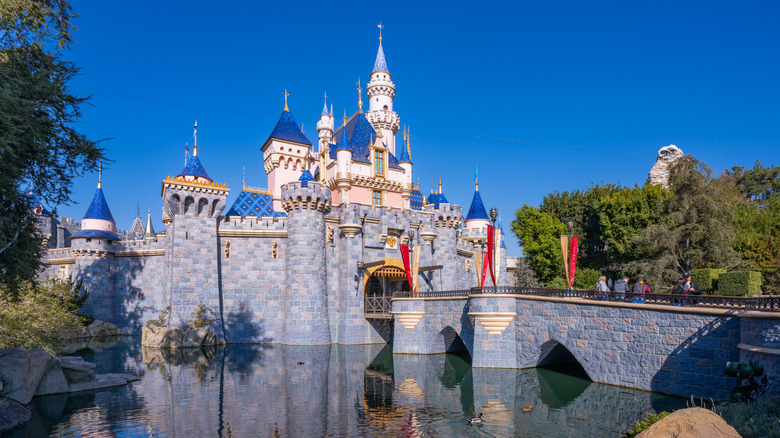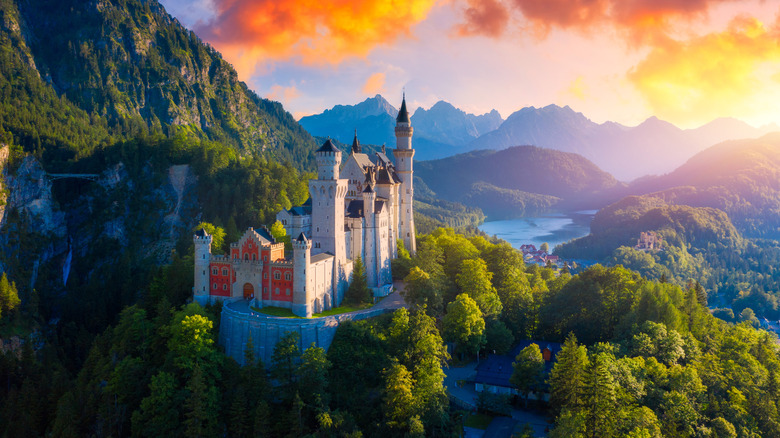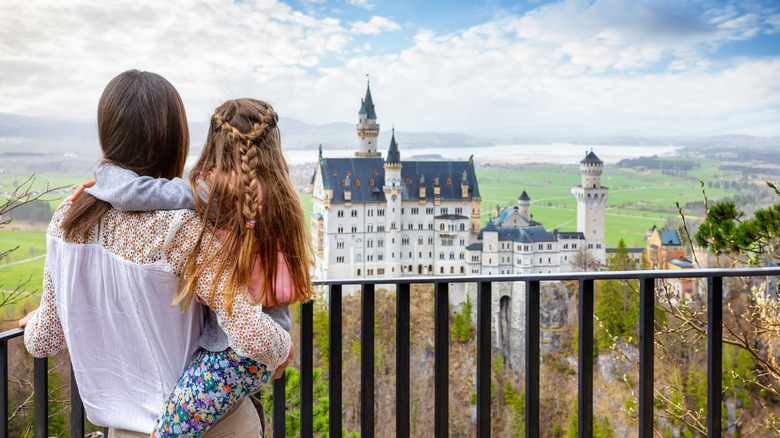One Of Europe's Most Mesmerizing Cliffside Castles Inspired Disney's Sleeping Beauty
Atop a cliffside in the Bavarian Alps of Germany sits an architectural marvel fit for royalty. Straight out of the illustrated pages of a fairy tale, Neuschwanstein Castle has been inspiring magical imagery since its opening to the public in 1886. Speaking of magic, one particularly famous man who based his entire career on the spark of imagination took inspiration from this castle to create the world-famous symbol known by millions of Disney fans worldwide: Sleeping Beauty's Castle. Before the construction of Disneyland in Anaheim, California, Walt Disney and his wife embarked on a European vacation and spent a bit of time visiting Neuschwanstein Castle. The rest is history. So if you're a Disney fan looking for a must-visit destination that isn't a park, put Neuschwanstein Castle on the top of your list.
Upon comparing the two castles, it's easy to see that Walt's inspiration for his design came from the beauty of Neuschwanstein Castle. After all, there were also real European destinations that inspired Cinderella's castle as well. Both Neuschwanstein Castle and its Disney counterpart have royal blue spires, a white-limestone facade, and elegant drawbridges over the water. More elusively, there's a certain sparkle to both fortresses –– though that may just be the twinkle lights in Disneyland. Unbeknownst to its eccentric original owner, King Ludwig II, often referred to as "the fairytale king," his castle would live on as not only a historical symbol but one of fantasy as well. However, the castle's origins and his own story are not as fairytale-esque as a Disney movie.
The fascinating history of Neuschwanstein Castle
In 1864, King Ludwig II began his short reign as King of Bavaria. During his rule, he seemed to live in a fantasy about what it meant to be a king. According to the Neuschwanstein Castle official website: "Ludwig II was possessed by the idea of a holy kingdom by the Grace of God. In reality, he was a constitutional monarch, a head of state with rights and duties and little freedom of action." After losing a war against Prussia, King Ludwig II had very little power, so he removed his focus from political affairs. Instead, shifted his attention to building Neuschwanstein Castle in 1869, a place fit for the idea of nobility he was so fascinated by.
King Ludwig II also had the interior built with all the technological advances of the age. Surprisingly, the building had central heating, hot running water, automatic flushing toilets, and even early renditions of telephones. Unfortunately, the project was so extravagant that it began to bankrupt the kingdom. According to the Neuschwanstein Castle website, starting in 1885, "foreign banks threatened to seize his property. The king's refusal to react rationally led the government to declare him insane and depose him in 1886." In a (perhaps) more fitting ending for a Brothers Grimm story, the day after he was arrested and taken to Berg Palace, King Ludwig II mysteriously died. Unfortunately for the monarch, he never got to see the completion of his castle –– nor did anyone else. Shortly after his death, work on the castle ceased and today, entire areas of it remain unfinished.
Visiting Neuschwanstein today
Despite King Ludwig II's vision never being completed, (only 14 rooms of the originally planned 200 are currently on display today) Neuschwanstein Castle attracts millions of visitors to its fairytale location every year. Visitors to the castle can see some of the interesting rooms that are on display such as a cave-like grotto, the king's bedroom, the throne room, and more. Based on location alone, any time of year is a delight to visit the castle. However, July and August are busy and the castle can see upwards of 6,000 visitors per day. Tours of the interior are only available through the Bavarian Palace Department, and it is advised to order your tickets online ahead of your visit.
Visitors can take advantage of the surrounding nature by exploring the nearby wooded areas, as well as taking advantage of the great viewpoint of the castle from the Marienbrücke bridge. Neuschwanstein Castle is located about two hours from Munich by car, and therefore a great excuse to take a scenic German road trip if you're willing to drive. There are also trains available to Neuschwanstein Castle from Munich but travelers will need to take a bus from the town of Füssen to reach it. Parking is also available in the town of Hohenschwangau and visitors can continue their journey from there by foot, shuttle bus, or horse-drawn carriage. Guided tours of the castle are available every day except for certain holidays. Although here you won't find the scent of churros as you do at Disneyland, a different kind of magic radiates from the walls of Neuschwanstein Castle.


